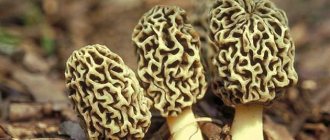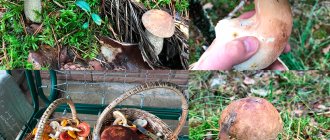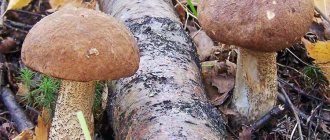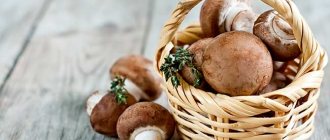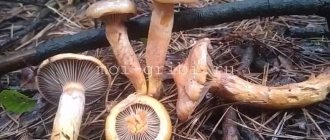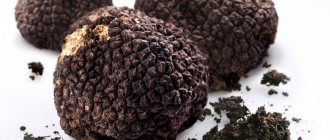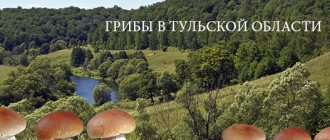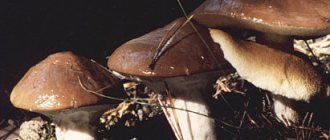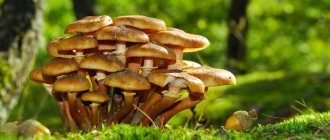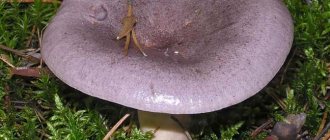Under natural conditions, a huge number of both edible and poisonous species of mushrooms grow, of which approximately eighty species are found on the territory of Ukraine. Major poisoning and intestinal disorders can be caused by inedible and poisonous or potentially dangerous mushrooms belonging to the twenty most common species. This year's season has become one of the most mushroom-producing ones, and the Ukrainian weather allows for the collection of fruiting bodies until the last days of autumn.
Mushrooms of Ukraine: list of edible and safe ones
The variety of mushrooms in Ukrainian forests is simply amazing.
We have about five hundred species, but out of these 500 hundred, no more than 35 species can be considered edible! These are, of course, everyone’s favorite honey mushrooms, boletus and chanterelles, porcini mushrooms, boletus, aspen mushrooms, Polish mushrooms and others. Composition of mushrooms First of all, they contain a lot of iron, as well as phosphorus, zinc, nickel, manganese, copper, chromium, sodium and iodine. Mushrooms also contain potassium, a microelement that supports the circulatory system and stimulates metabolism, as well as B vitamins, which have a beneficial effect on the nervous system, the beauty of nails and hair. Mushroom pulp also contains other vitamins: A, D, C and PP. Moreover, they contain the same amount of the latter as in yeast or beef liver. In addition, wild mushrooms are rich in lecithin, a substance that prevents the deposition of cholesterol on the walls of blood vessels, so mushroom dishes can serve as a preventive measure for atherosclerosis.
Why are mushrooms dangerous? Despite the fact that mushrooms are a plant product, they contain a lot of proteins (from 30 to 35%). But the trick is that mushroom protein is very hard, about the same as that of legumes (beans, soy). This is why mushrooms take a long time and are difficult to digest. On average, this takes from four to six hours instead of the required two. On the one hand, this creates a feeling of fullness, and on the other, it puts a lot of stress on the gastrointestinal tract, especially if it is a child’s immature stomach.
Who are mushrooms contraindicated for?
- people suffering from stomach ulcers, gastritis, pancreatitis and cholecystitis;
- children under 5 years old;
- patients who have undergone surgery or an infectious disease;
- people with intolerance to a specific carbohydrate - trehalose, which is found in mushrooms.
Why experienced mushroom pickers make mistakes Even an experienced mushroom picker is not immune from poisoning. And this is not a matter of optical illusion, but of the unfavorable ecological situation of our forests, the soil of which no one ever tests for the content of radionuclides, pesticides, heavy metals and other toxic substances. But mushrooms, like sponges, absorb everything that is contained in the ground: be it the cadaveric poison of a rodent that died nearby or pesticides hidden in the ground by someone unknown.
Signs of mushroom poisoning
- the first thing you need to pay attention to is abdominal pain and nausea, which appear 2-3 hours after eating mushrooms;
- after this, uncontrollable vomiting and severe diarrhea may begin;
- although some types of mushrooms can make themselves felt after 6-8 hours, or even after 8-10 hours. Moreover, the symptoms of poisoning are the same: nausea, vomiting and diarrhea;
- after the first attack of toxic poisoning, a period of improvement may occur, which usually lasts several hours;
- 10-12 hours after poisoning, symptoms of damage to the liver by toxins may appear - yellowing of the skin, heaviness and pain in the right hypochondrium, enlarged liver and other signs of toxic hepatitis.
What to do in case of mushroom poisoning At the slightest suspicion of mushroom poisoning, you should immediately call an ambulance! Before she arrives, try:
- drink as much water as possible with a weak solution of potassium permanganate (at least a liter) and provoke vomiting;
- after this, you can drink activated carbon (1 tablet per kilogram of weight), which will collect and remove remaining toxins from the body;
- if there is no diarrhea, you can drink a spoonful of castor oil or sorbitol (at the rate of 2 g per kilogram of body weight);
- Place a heating pad on your legs and stomach. Do not take antiemetics or astringents under any circumstances, as they interfere with the natural cleansing of the body from toxic substances that cause poisoning!
Edible mushrooms of Ukraine
- Porcini
- Oyster mushroom
- Volnushka
- Gruzd
- Chanterelles
- Oiler
- Mosswort
- Honey mushrooms
- Podbrezeovik
- Boletus
- Polish mushroom
- Ryzhik
- Cobweb
- Russula
- Champignon
- May mushroom
- Early field grass
- Common dubovik
- Talker
- Blackberry yellow
- Pink lacquer
- Milkman
- Variegated umbrella
- Golovach
- White steppe mushroom
- Caesar mushroom
- Bolethin swamp
- Semi-white mushroom
- Porkhovka
What's in the forests
The assortment is not that large, so it won’t take long to study the varieties of mushrooms. I will name the mushrooms that are collected and eaten in our family: porcini mushroom, Polish mushroom, boletus, boletus, butterdish, russula, rows, umbrellas, raincoats, goats, jaundice, white mushrooms, white and black milk mushrooms, field champignon (pecheritsa), field honey fungus , saffron milk caps, moss fly.
RyzhikWikipedia
Saffron milk mushrooms and moss mushrooms come across very rarely, but they are very tasty. One day we stopped to ask the traders whether the mushrooms we found were edible. It turned out that they were saffron milk caps. For the first time I saw such rounded eyes from sellers, plus a lot of questions about where we found them.
White and Polish mushrooms collected near SvyatogorskSvoi.City
porcini mushrooms, Polish mushrooms, goat mushrooms and field mushrooms , but send them for drying. Under no circumstances should you wash them - just wipe off the dirt and cut them into slices. Three to four days under a fan, and can be stored in tightly closed containers. During this time, the room is filled with an amazing aroma.
During the season, the abundance of boletus in our area can only be competed by the rower and the goatsSvoi.City
Butter is mainly pickled. But you can also dry part of the harvest so that in winter and out of season you can pamper yourself and your guests with mushroom soup.
Inexperienced mushroom pickers often bypass the umbrella, thinking that it is not edible.City
Umbrellas and raincoats do not need to be cooked; just fry them and you can serve them. If you have collected a lot of raincoats, then marinate them.
Jaundice or yellow row begins to appear in baskets before the end of the mushroom seasonpinterest.com
In the first days after the rain, you can find clearings dotted with raincoatsSvoi.City
Squirrels and jaundices begin to grow from the sand with the arrival of the first frosts on the soil. We marinate these mushrooms. Before doing this, they need to be washed well, and then filled with cold salt water for several hours so that the salt comes out of the plates.
Pecheritsa grows in pasturesSvoi.City
Boletus, boletus, russula, row, milk mushrooms, pecheritsa - marinate or fry. By the way, russula are very brittle, so they need to be transported carefully, and before processing, pour boiling water over them to make them more elastic.
Poisonous mushrooms of Ukraine
Mushrooms are a favorite delicacy of quite a large number of people. However, not all mushrooms are safe. This is due to the fact that today in the forests of Ukraine there is a fairly large number of non-edible varieties of this product.
In order to distinguish an edible mushroom from an inedible one, sometimes it is not enough to simply look at a photo of the pest. Some bad mushrooms are very similar to their edible relatives and only a professional mushroom picker with many years of experience can distinguish them. The appearance of mushrooms is very deceptive, which can subsequently cause the most dangerous poisoning and even death.
From all that has been said, we can conclude that before the start of the mushroom season, it is imperative to learn how to distinguish bad mushrooms from good ones. Next, it is worth conducting an overview of the most dangerous varieties of mushrooms that grow on the territory of Ukraine.
Death cap
This type of inedible mushroom annually claims a fairly large number of human lives. This is due to the fact that the external characteristics of this mushroom are practically no different from its edible relatives.
Toadstool can cause enormous damage to human health by damaging organs such as the liver and kidneys. However, it is worth noting that the first indicators of severe poisoning may appear when it is no longer possible to do anything. As a rule, after consuming this mushroom the outcome is almost always fatal.
The distinctive features of this mushroom are practically invisible. The most basic differences lie in the stem of the mushroom.
Pale toadstool can be confused with such commonly exterminated mushrooms as champignons, russula and umbrella mushrooms.
Death cap
Boletus yellow-brown
The yellow-brown boletus (or aspen boletus) is an unusual representative of eukaryotes, which differs from other edible relatives by its scaly leg:
- the cap is large, reaching 20 cm. It is not very voluminous, yellow-brown in color with smooth edges;
- The scaly leg is usually large, thick, and proportionally high. Black scales highlight the white leg;
- The boletus pulp is fleshy, tasty, but does not have a pronounced odor.
The boletus prefers young deciduous and mixed forests and appears in June and disappears in October. Mushroom pickers usually harvest their largest harvest in mid-September.
Boletus is similar exclusively to mushrooms from its own family and differs only in color. This product is great for pickling. Salted or pickled boletuses turn out worse because they lose their shape.
Fly agarics
Also from children's books, according to the photo, we know that fly agaric mushrooms have a rather bright appearance and are inedible mushrooms. However, modern mushroom farming knows a large number of varieties of this type of mushroom, some of which can be conditionally eaten. The fly agaric genus can number about 600 species. Among the most common are the following varieties of fly agarics:
- Red fly agaric;
- Panther fly agaric;
- Green fly agaric;
- Stinky fly agaric;
- White fly agaric.
This type of mushroom is highly poisonous. It is second only to the pale grebe. In the forests of Ukraine, you can most often find the red and panther fly agaric, therefore, the latter is sometimes quite difficult to distinguish from edible varieties of mushrooms.
As a rule, fly agarics grow not far from tree species such as oak and beech, and they also prefer soils with a high alkali content.
The consequences of exposure to fly agarics can be as follows:
- An unreasonable attack of anger;
- Visual and auditory hallucinations;
- Loss of consciousness;
- Coma;
- Death.
fly agaric
Pine mushroom
Pine saffron milk cap (or Lactarius deliciosus) is a delicacy mushroom. You don’t need to soak it, you can’t even soak it, and you can eat it straight raw:
- it has a large red cap of irregular round shape. The color can vary from light red tones to rich ones;
- the stem is low, but greatly widening towards the cap. It has a ribbed, tubular shape;
- The flesh of the camelina is very dense, rich in aroma and tasty. Many gatherers eat it right in the forest.
These delicacies grow near pine trees, right in the pine needles.
They appear in the middle of summer and do not cease to delight until the very beginning of winter. Saffron milk caps are easily confused with milkweeds. It is not dangerous to health, but the milkweed does not have the same taste and aroma. You can cook anything with saffron milk cap, but it’s best to just eat fresh pickled mushrooms. Did you know? Scientists have proven that the kingdom of fungi has existed for more than 400 million years, which means that they are older than dinosaurs.
Satanic mushroom
The toxicity of this type of mushroom is quite high. Just one gram of this poisoned product can cause quite a lot of poisoning. If the mushroom is subjected to a sufficiently long boiling process, these toxins are not released.
These mushrooms reach quite large sizes. The color of the mushroom can vary from white to gray or olive.
The most common period for harvesting these inedible mushrooms is June-October.
Satanic mushroom
Bile mushroom
This poisonous mushroom is a double of the well-known porcini mushroom. However, the description of this poisonous mushroom provides for a distinctive bitter taste of the soft body of the mushroom, pink pores, and the formation of an atypical black mesh directly on the stem itself.
It is worth noting that the variety of this variety of mushrooms may also include the usual taste of a mushroom, akin to porcini; if these mushrooms grow in forest clearings, then they may differ in a lighter-colored cap and an almost smooth stem. Due to the fact that it can disguise itself as other mushrooms, it can sometimes be confused with a mushroom such as boletus.
The growth period is June-November. These representatives of poisoned mushrooms grow in the Forest-Steppe or Polesie.
Bile mushroom
Volnushka white
White trumpet (or whitefish, fluffy whitefish) is a representative of the Milky family, which has an incredibly pleasant taste and alluring aroma.
It’s not so easy to meet a whitefish, so you need to know what it looks like so you don’t miss:
- the cap is light (white or cream) in color with a diameter of 5-8 cm. The reverse side of the top is usually darker, but of the same shade. Volnushka is the only mushroom that has a fluffy (shaggy) covering of the cap, especially pronounced on the sides;
- the leg is disproportionately short (3-5 cm), usually white and also has slight fluff;
- The pulp is usually not hard, quite juicy, and white.
Fluffy eukaryotes grow in birch groves or mixed forests, a common tree of which is necessarily birch. The mushroom usually appears from late August to late September.
Find out where volnushki grow and how to avoid getting caught by their double.
Belyanka is very similar to white podgruzdok and pink wave.
Podgrudok white These eukaryotes are edible and are very similar in taste to whitefish. It is easy to distinguish them from the podgruzka - the cap of the latter is smooth and does not have the characteristic “hairs”, and the pink wave has a pink tint.
They can be used for food only as pickles and only with preliminary soaking and boiling. When salted, the cap remains intact fleecy and acquires a pleasant delicate taste.
Thin pig
This mushroom is not a cause of death, but its use in food is strictly not recommended. This is due to the fact that the toxins contained in this type of mushroom can have a detrimental effect on the kidneys and also significantly reduce the number of red blood cells in human blood. The first manifestations of poisoning appear quite late and all therapeutic measures aimed at eliminating the symptoms are carried out with great difficulty. The thin pig mushroom is often confused with the thick pig mushroom, which in turn is an edible mushroom, but it is quite rare to find it in our forests.
boletus
Many mushrooms love birch, but boletus can only be found under this tree:
- it has a small, rather voluminous cap (5-12 cm), brown in color, often of an imperfect round shape;
- the leg is long, smooth, slightly narrowed closer to the top;
- The pulp is loose, airy, pleasant in smell and taste.
Boletus in cross section The boletus is usually found in deciduous forests next to birch trees from mid-summer to mid-autumn. The common boletus is very easy to confuse with its poisonous relative, the gall fungus. When these mushrooms are cut, it is clearly visible that the edible mushroom does not change color, while the gall mushroom immediately acquires a reddish tint.
This product can be prepared in any form; it is delicious fried, pickled or salted.
Gall mushroom in section
fiberglass
Poisonous mushrooms of Ukraine include several varieties of this type of mushroom. Most often, you have the opportunity to encounter brown fiber. They can be found throughout Ukraine, both in coniferous and deciduous forests. The period of active growth is July-November. The smell of these mushrooms is unpleasant, and their appearance boils down to white pulp, which can change color when cut. The cap can reach five centimeters in circumference and be shaped like a cone.
This variety of this breed of poisonous mushroom, like the cone-shaped whip, can sometimes be confused with the most common honey mushroom.
For the most part, this mushroom grows in the Carpathian region, Forest-steppe and Polesie, however, as previously noted, it can be found throughout Ukraine.
Patouillard fiber is one of the most poisonous varieties of fiber. This variety grows in most deciduous forests.
This type of mushroom can be confused with edible mushrooms such as champignons or caps. However, fiber, unlike them, differs from them in containing such a potent toxic substance as muscarine.
fiberglass
Oyster mushroom
Oyster mushroom (oyster mushroom, oyster mushroom, lump) is an incredibly valuable find, because this mushroom is very tasty and is easy to propagate in your own summer cottage.
The appearance of oyster mushroom is very characteristic, so it is quite difficult to confuse it with any other species:
- The head of the lump is very similar in shape to the human ear, has a matte finish and can be white or ashy in color. The diameter of the “top” varies from 5 to 25 cm. Since oyster mushrooms grow in groups, the mushroom caps together form the shape of a multi-tiered fan. They have a very weak aroma, but incredibly pleasant;
- the leg of the block is lateral, short (2-3 cm), almost invisible, light in color;
- Oyster mushroom pulp is very dense, has a pleasant aroma and rich taste, making dishes more juicy.
Oyster mushrooms prefer to grow in many countries in mixed, deciduous and coniferous forests on rotten stumps and dead trees. The easiest way to find a fan of them is near birch, willow or aspen trees.
Important! In many countries, this mushroom is grown artificially for wholesale sales.
Oyster mushrooms prefer to appear during the subsidence of the heat, namely from the end of September to the end of December, because this species does not tolerate high temperatures.
The common oyster mushroom is very easy to confuse with other representatives of the same family. For example, the orange oyster mushroom is very similar to the oyster mushroom, but its color will give it away, although the shape and general appearance are completely identical.
There are no poisonous analogues of oyster mushrooms in Ukraine, so when collecting it is enough to pay attention to the shade. Only light or grayish representatives will be tasty.
Oyster mushrooms can also be grown at home and frozen or dried for the winter.
Lumps are universal eukaryotes: they can be used in any form (pickled, fried, pickled), so when choosing dishes, any housewife will be at a loss, because they can be used to make a lot of tasty and aromatic culinary masterpieces.
Entoloma poisonous
This type of mushroom is characterized by a high content of toxins that can cause poisoning to the human body.
Poisoning usually ends in death, since the poison is very toxic.
This type of mushroom can be found both in parks and in most deciduous forests.
According to medical reasons, treatment after poisoning with this type of mushroom should be aimed at gastric lavage and administration of blood substitutes in order to completely cleanse the human body of toxins.
To summarize, it is worth noting that almost all inedible mushrooms that grow in the forests of Ukraine can cause colossal damage to human health. To prevent this from happening, you should collect only those mushrooms that are edible and after collecting, consult with experienced mushroom pickers about the suitability of eating a particular variety of mushroom. Only after this should you properly process the harvested crop and eat it without fear.
Kozlyak
Kozlyak (or reshetnik) is a mushroom that prefers to grow in coniferous forests and is not a first-class mushroom, but is somewhat popular among mushroom eaters:
- The cap of the lattice is quite large (from 5 to 12 cm), red or brown in color, quite voluminous. At the bottom of the apex there is a dense tubular layer;
- the leg of the goat is proportional to the cap (5-12 cm), but may be somewhat shorter, which makes it less noticeable;
- The pulp is yellow or brown in color and tends to acquire a pink tint when cut.
The lattice mushroom can only be confused with a pepper mushroom, but an experienced mushroom picker who knows what a goat mushroom looks like will probably notice that the pepper mushroom is much smaller in size, and its taste is different from the lattice mushroom (it has bitterness).
There are a wide variety of dishes that can be prepared from this product, but the pulp must undergo heat treatment before use. Important! Goat meat is not suitable for pickling or salting.
Mushroom places in Ukraine
In recent years, mushroom tourism has become especially popular, which involves not so much the cultivation of edible species, but the collection of forest varieties with very high nutritional value. Popular mushroom spots among mushroom pickers include:
- Carpathian region , represented by massifs between rivers on the border of such regions as Lviv and Ivano-Frankivsk. On the territory of the Skole Beskids nature reserve, consisting of beech conifers, more than five dozen species of edible mushrooms grow, including porcini and boletus, russula, boletus and honey mushrooms. The best places for collecting mushrooms are the surrounding areas near the villages of Oriv, Tukhlya, Oryavchik and Grebennoye. The average distance from Lviv is just over one hundred kilometers;
- Carpathian highlands , represented by elevated areas of mountainous and wooded terrain. In this regard, forest areas near the village of Verkhovyna in the Ivano-Frankivsk region are perfect for “silent hunting,” where porcini mushrooms, chanterelles, boletus and russula grow in abundance. Experienced mushroom pickers go to collect mushrooms in Mykulychyn or Yablunytsia, which can be reached not only by private car, but also by public or tourist transport;
- Bukovyna in the Chernivtsi region , represented by vast beech forests, is a real paradise for experienced mushroom pickers and simple amateurs. It is here that the highest yield of very large porcini mushrooms is recorded annually. Among the settlements included in numerous modern ecotourism trails are the villages of Sergii and Zelenaya, as well as Vizhenka. Organized ecotourism is based on a “silent hunt” accompanied by an experienced guide who is able to show the best mushroom spots;
- The Lviv region is rich in boletuses, boletuses, honey mushrooms and porcini mushrooms, which grow in abundance in the wooded mountainous areas in the Starosambir, Turkiv and Skole districts near the villages of Skhidnytsia, Slavskoe and Likhobora;
- Ternopil region , including the Monastyrsky and Shumsky districts, is characterized by active fruiting of porcini mushrooms and honey mushrooms, and boletus and boletus mushrooms grow in the Mshanetsky forests, as well as boletus. It is recommended to go to the Kremenets Mountains to collect boletus mushrooms;
- Cherkasy region , where a large number of large forests are concentrated, is famous for porcini mushrooms and butter mushrooms. Close to Kanev there is the famous Buchatsky forestry, which has become very popular due to the annual and very abundant fruiting of honey mushrooms.
It is also worth noting the abundance of mushrooms in forests located near the regional center of Kelmentsi, in the vicinity of Lake Synevyr and near the villages of Lumshory, Dragovo and Vyshka, as well as Kolochava. Mushroom abundance is observed in remote villages of Svalyavsky and Mukachevo regions.
Spring mushroom picking season in Ukraine
The first spring mushrooms most often appear in forest areas located on both sides of the Kiev Sea. It is here that chanterelles, boletus, white and saffron milk caps, as well as russula, from which, as a rule, only the caps are collected, appear to replace the strings, morels, oyster mushrooms and rows. Under favorable weather conditions, in the last ten days of spring, the May or St. George mushroom appears, as well as boletus and other most unpretentious and widespread spring-summer varieties of edible mushrooms.
What edible mushrooms grow in Ukraine in May
Edible mushrooms are eaten without risk to life and health, even without subjecting the fruiting bodies to preliminary strong heat treatment. As a rule, such species have a very high gastronomic value and are extremely popular among mushroom pickers.
May row or St. George's mushroom
Appears in forest areas on St. George's Day. The taste of the fruiting bodies of this type of spring mushroom resembles the pulp of the common morel. In some countries, this variety is considered a delicacy and is widely used in the preparation of various mushroom dishes, but in our country it is collected exclusively by amateurs.
Morel cap
It is most often found in aspen forests, as well as in damp places in lowlands where there is no high grass stand. Prefers areas covered with last year's leaf litter. The main fruiting season of the morel cap occurs in early or mid-April, and the duration of harvesting the fruiting bodies does not exceed two weeks.
Oyster mushroom
The cap is shell-, ear-shaped or tongue-shaped . The surface is most often broadly funnel-shaped, smooth, dark in color, grayish-brown, black-brown with a slight bluish tint. The leg is cylindrical, with hairy pubescence, white or brownish in color. The pulp is white, soft or slightly harsh, without a pronounced mushroom aroma or taste.
Oyster mushroom covered
It grows in large groups in May, on dead wood and fallen aspens. The cap is sessile, kidney-shaped or fan-shaped, with folded or downturned edges. The base is convex, smooth, bare, slightly sticky. The cap is brownish-gray or leathery-brown in color, with radial stripes. The plates are relatively frequent, wide, radial-fan-shaped with uneven edges, yellowish in color, covered with a light membranous blanket. The pulp is fleshy, of sufficient density, whitish in color with the aroma of raw potatoes.
Gray row
Ryadovka gray (Ryadovka hatched, little mouse (mouse, little mouse), pine pine, green grass, gray sandpiper, serushka) is an edible mushroom that belongs to the Ryadovkov family:
- the mushroom has a dark gray cap measuring 15 cm. Often in the center of the top there are ray stripes of a dark shade. The older the eukaryote becomes, the less attractive the surface appears;
- the stem of the rows is proportionally long and white;
- The pulp is usually gray, has a floury taste and a pleasant delicate aroma.
Gray row Mice grow in pine forests, mainly in the cold season, when there are no other mushrooms.
Pine pine grows in moss alone or in small groups. The gray mushroom can be confused with a representative of the same genus - the mouse row, which is very dangerous, because the latter mushroom is poisonous. However, there are quite clear differences between them: the gray row has a more pronounced contour of the cap.
Poisonous mouse row Mouse is an incredible find, because you can prepare any dish from it, but pre-treatment (20-minute boiling) is required.
Inedible and poisonous: which mushrooms should Ukrainians be wary of?
Before the start of the mushroom season, it is important to learn to distinguish which mushrooms are inedible and even deadly to humans. We offer an overview of the most poisonous mushrooms that are found in our latitudes.
According to the Ministry of Health of Ukraine, the largest number of fatal cases of mushroom poisoning each year occur due to the consumption of toadstools.
Death cap
Pale toadstool is considered the most dangerous of the mushrooms growing in our latitudes. Even a small piece of toadstool can cause irreparable damage to human health. This fungus affects the liver and kidneys, and symptoms of poisoning appear when the person can no longer be helped.
Poisonous false honey fungus
The danger of this mushroom is that it can be confused with edible honey mushrooms. The main toxic substances are aldehydes and ketones, which have a strong irritating effect on the mucous membrane of the stomach and intestines. Death occurs only when eating a large number of mushrooms. Children and older people are more susceptible to toxins from the fungus.
The convex cap is yellow-gray, yellow in the center with a reddish tint, usually up to 6 cm in diameter. The plates are olive or gray-yellow in color. The green tint - at the top of the stem, on the plates or along the edge of the cap - is an important distinguishing feature of the poisonous honey mushroom.
The stem of the mushroom is cylindrical, empty inside, and has a red tint at the base.
When broken, the flesh of the mushroom is gray-yellow, with a very unpleasant odor. It tastes very bitter.
Fly agarics
Despite the fact that the fly agaric with a red hat with white speckles is in the public consciousness a symbol of all poisonous mushrooms, in fact it is a genus of more than 600 species, among which there are conditionally edible and at least six completely edible species of fly agarics.
Highly poisonous are the red fly agaric, the green fly agaric, the stinking fly agaric, the panther fly agaric, and the white fly agaric. Most often, in the mushroom places of Ukraine - in the Zhytomyr, Chernigov, Kyiv regions - panther fly agarics are found.
Panther fly agaric usually grows next to oak and beech, preferring alkaline soils.
Poisoning with panther fly agaric, like red fly agaric, initially causes attacks of anger with a desire to destroy. This is followed by visual and auditory hallucinations. In case of severe poisoning, loss of consciousness, lethargy, memory loss occurs, and in severe cases, coma and death.
Satanic mushroom
This mushroom is highly toxic, which persists even after prolonged cooking. It is known that even one gram of mushroom causes severe poisoning.
It reaches large sizes at the end of summer; its round, cushion-shaped cap grows up to 30 cm, and its massive leg can be 15 cm in height and 10 in width. Mature representatives have a more prostrate shape. The skin on the cap is velvety, sometimes smooth to the touch, and dry. Color varies from white to dirty gray and olive. The flesh turns a little blue when cut, sometimes turns red.
In Ukraine it occurs from June to October in the forest-steppe and especially in Polesie.
Entoloma poisonous
A very dangerous poisonous mushroom, common in the Carpathian region.
Grows in virgin steppes, occasionally in deciduous (oak, beech) forests. But by the beginning of autumn, poisonous entoloma disappears.
fiberglass
There are several types of poisonous fibers present in Ukraine. The most common fibers are brown. They grow throughout Ukraine in coniferous and deciduous forests from July to November. This mushroom has an unpleasant odor; the white flesh does not change color when cut. Height - 5 cm, thin stem. The cone-shaped hat reaches five centimeters in diameter.
Another type of this mushroom, known as the cone-shaped mushroom, is sometimes mistaken for the real mushroom.
The rarer Patouillard fiber is also highly poisonous.
These mushrooms grow in deciduous forests, on the edges, clearings, in parks, under oak and linden. In Ukraine, such fibers can be found from May to August in Polesie and the Forest-steppe.
This mushroom is sometimes mistakenly collected instead of champignons or cap, from which it differs in the shape of the cap, the absence of a ring on the stem, and the light color of the plates. Contains a toxic substance - muscarine.
Bile mushroom
This is an inedible double of the porcini mushroom, from which it differs in the bitter taste of the pulp, pinkish pores and the presence of a black mesh on the stem.
There is a variety of this mushroom with a pleasant-tasting pulp - the yellow gall mushroom, which grows in forest clearings, is distinguished by a lighter cap and an almost smooth stem. The gall mushroom can also be confused with the boletus mushroom.
Distributed in Polesie and Forest-steppe. Grows in coniferous forests from June to November.
Thin pig
This is not a deadly mushroom, but it is still harmful to health and is not recommended for consumption.
Because of it, the number of red blood cells in the blood decreases, which has a detrimental effect on the kidneys. As in the case of toadstool, symptoms of poisoning with toadstool appear very late.
The thin pig is often confused with the edible fat pig. This mushroom is not dangerous and has good taste, but is not so often found in Ukrainian forests.
Real milk mushroom
Real milk mushroom (or white milk mushroom, raw, wet or pravsky) is one of the most delicious mushrooms from the russula family:
- The milk mushroom cap usually has a diameter of 5 to 20 cm, with a funnel in the middle of it. The skin is mucous, milky or white, often with particles of earth or grass;
- The leg of milk mushrooms is usually small (3-7 cm) in the shape of a cylinder, pleasant to the touch, white or yellowish in color. There is a cavity inside the stem of this mushroom;
- The pulp is very fragile, quite dense, has a white tint and a pleasant fruity aroma.
Important! The appearance of brown spots on the surface of the mushrooms indicates that they are already quite old.
You can meet real milk mushrooms in mixed or deciduous forests. The main condition for the growth of these mushrooms is the presence of birch, aspen or linden trees in its environment. They usually grow in small groups, and mushroom pickers really hunt for them. Those who want to enjoy milk mushrooms need to go out to get them as soon as the sun rises. The most optimal time for these representatives is July, August and September.
It is quite difficult to confuse a milk mushroom with any other mushroom due to the peculiarity of its cap, namely that same funnel.
In many countries of the world, milk mushroom is considered an inedible mushroom, but in some CIS countries it is conditionally edible and is only suitable for pickling. However, they do need to be soaked for a long time, but for such an excellent taste it is definitely worth it.
We advise you to find out what types of milk mushrooms exist, how these mushrooms are useful and how to properly prepare milk mushrooms for the winter.
Edible mushrooms of Ukraine: market overview
A rich raw material base, relatively cheap energy and human resources, and long-term cold seasons stimulate the development of a powerful industry for the production of cultivated mushrooms.
The Ukrainian mushroom production market is in line with global trends, the annual increase in mushroom production is 6-8% per year. The domestic market has shown growth from 6-12% (according to Ukrainian producers) to 15-20% (according to Russian experts) over the past 7 years.
The rapid development of mushroom cultivation is due to the fact that:
- mushrooms are a source of proteins, vitamins, microelements and medicinal substances
- mushrooms are the most productive crop in agriculture
- technology for the production of edible mushrooms is environmentally friendly and waste-free
- mushrooms convert agricultural waste into food and medicine
In general, the mushroom market in Ukraine can be divided into two submarkets: the market for cultivated (cultivated, industrial) mushrooms and the market for forest (wild) mushrooms.
It is impossible to accurately assess the market for harvesting forest mushrooms; the market is unpredictable, since a significant amount of mushrooms are collected by the population for their own consumption, and the majority of market players work in the shadows. Among the characteristic features of the market, it is worth mentioning pronounced seasonality, significant and sharp price fluctuations, and the dependence of the harvest on natural conditions. Enterprises that constantly and legally operate on the market send 50 to 90% of their products for export. In 2012, a significant increase in the collection of forest mushrooms (and their exports, respectively) is expected due to the fact that this year there was a record mushroom harvest (three times more than the 2011 harvest).
The end of the 80s of the twentieth century was marked by the development of mushroom production in Ukraine, which at the initial stage was of an amateur nature. The USSR understood the prospects of growing mushrooms on an industrial scale, but the development of this direction was limited only to the creation of several experimental enterprises for growing champignons. In the first half of the 90s, small private farms were engaged in growing mushrooms, the total production volume of which did not exceed 400-500 tons per year.
